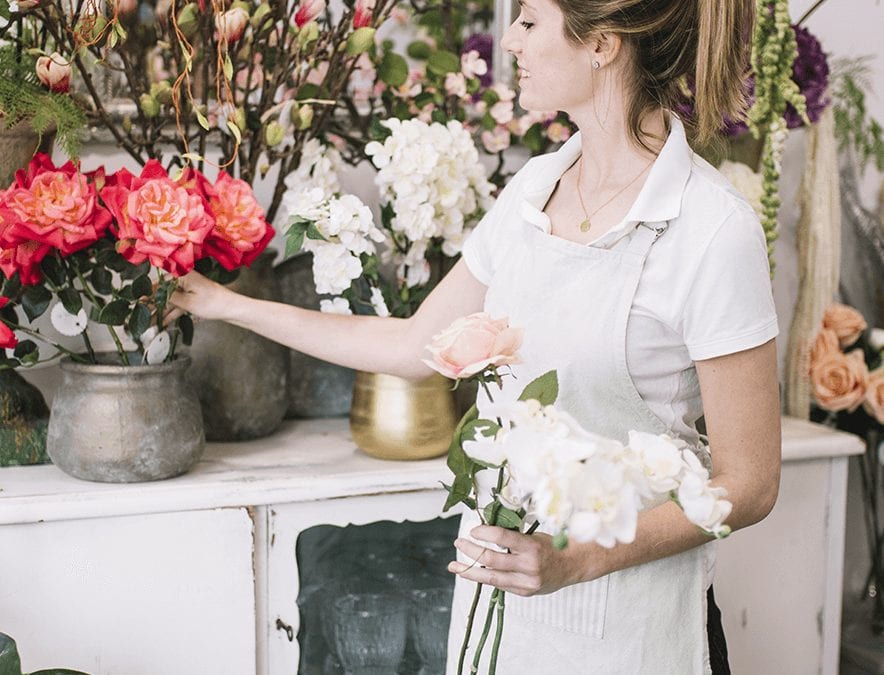The floral professional’s role is to connect consumers with the natural world through artistry and design. So it’s no surprise that the emerging themes of this year’s “Slow Flowers Floral Insights and Industry Forecast” include ideas that strengthen community ties with value-driven consumers and nurture entrepreneurial innovation in horticulture and floriculture.
“When local floral agriculture partners with independent grocery stores, great things happen.”
My annual Slow Flowers report on leading topics influencing the domestic floral marketplace includes cultural shifts and a convergence of collective ideas and attitudes. In recent months, I’ve shared many of these ideas at Hitomi Gilliam’s Trend Summit 2019, the Association of Specialty Cut Flower Growers’ annual conference and the Southern Flower Symposium. If you’re an “early adopter,” these concepts may resonate or reinforce your current approach to sustainable design.
Methodology
For each of the past five years, I have drawn from a number of sources to develop this annual forecast. Sources include hundreds of first-person interviews for print and digital stories, input from the Slow Flowers Community, past guests of the Slow Flowers Podcast and the attitudes of progressive leaders in the floral marketplace – farmers, florists and design creatives – who together inspire this “floral futures” report. I hope you find these forward-thinking resources important and valuable. I’d love to hear your feedback and suggestions. You can find an expanded version of this report, including a free PDF, at slowflowersjournal.com.
No. 1: Experiences, Not Conveniences
In a retail climate where Amazon is king, those who engage floral consumers in authentic, tactile, visceral experiences will break through the click-and-buy mindset. Customers who connect with you, your story, your flowers and the origin of those flowers are the foundation of a loyal tribe.
And while efforts and actions that strengthen our ties with customers isn’t an entirely new concept, it is one you must habitually practice, especially in today’s cluttered and distracting marketplace. Events, tours, workshops and other experiential programming are critical – and much more powerful than touching customers through social media channels alone.
Experiences can occur in small yet significant ways. Invite a flower farmer to share a demonstration or participate in a giveaway to promote a special floral crop this year. Like the food sample stations at Costco, you’ll draw curious customers enticed by something free or new. More powerful than social media channels alone, find ways to engage your customers far beyond the convenience of cash-and-carry.
No. 2: Artisan, Not Mass-Produced
When you embrace this artisan ethos, the conversation moves away from flowers as a price-sensitive commodity to flowers with high value-added perception. As botanical ingredients migrate further into the worlds of fashion and couture (yes, Beyoncé and her floral headpiece appearing on the cover of last September’s Vogue comes to mind), they are quickly becoming objects of desire in a new way. The explosion of floral wearables, floral couture and jewelry alike, ignites the imaginations of your clients. Handcrafted products, as well as botanical collections, will differentiate you and your brand.
This approach is particularly appealing to younger female customers. Start during prom or wedding season with floral crowns, cuffs and tattoos instead of the predictable wrist corsage or bouquet. You’ll excite staff and shoppers alike by moving everyday flowers into fashion-forward accessories.
No. 3: Floral Expressions, Not Floral Arrangements
Credit for this phrase goes to Tomas De Bruyne, who uttered it during his presentation at the 2018 American Institute of Floral Designers’ (AIFD) Symposium. It truly resonates as a design philosophy of infusing relevance into what is so often the day-to-day, production-based floral marketplace.
Enticing the senses, setting a mood, emphasizing place and season – these themes enhance what sometimes feels prosaic. Incorporate uncommon ingredients, especially those unique to your geographic region, into seasonal displays. Novelty crops such as fruiting branches, native perennials and colorful foliages add an unexpected garnish to arrangements. Give design staff the freedom to experiment, allowing a centerpiece or hand-tied bouquet to represent so much more than stem-count or price.
No. 4: Environmental, Not Synthetic
Natural, tactile and organic are terms that emerge in this concept, one that returns us, quite literally, to the roots of this profession. Expressing our earthy ties requires peeling back the veil and revealing how plants grow, an unfiltered “behind the scenes” approach to our work.
Tap into that curiosity, and give your customers access to the process, be it teaching them how to force bulbs indoors during the winter or how to turn cut succulents into floral arrangements by wiring a stem (and later replanting for summer containers). Revealing root balls, seedlings, bulbs and tubers as part of the finished design is one easy way to underscore the ties to farmland and agriculture. Wild or cultivated, nature at all stages fascinates and provides access to unique sources.
No. 5: Vertical, Not Compartmentalized
More florists are becoming their own source for everything from cut flowers to value-added products (vases, accessories, linens, tools) as a way to capture more profits and reclaim revenue. The opportunity to “sell to yourself ” has fueled the farmer-florist model, and increasingly, studio and retail florists are planting seeds to attain affordable luxury – flowers to grow and harvest for their own channels.
There are innovative crossover and collaborative opportunities, as well, such as April Lemly’s Kamama Flowers, which has co-located with Peninsula Taproom, in Sequim, Wash., two businesses with a shared marketplace. Using #flowersandbeer to reach a crossover demographic base makes this strategy a natural while also reducing overhead for two retail storefronts.
Translated to the supermarket level, this concept can work in tandem with adjacent store departments. How can you promote local wines and local flowers? How can you tap the produce department for fun, veggie-themed bouquets or unique vessels? Stretch your definition of floral to move across other categories and stimulate a curious and engaged clientele.
No. 6: Relational, Not Transactional
I keep returning to the oft-quoted Seth Godin saying, “People do not buy goods and services; they buy relations, stories and magic.” In today’s transactional climate, florists who can find authentic and relevant ways to engage with customers while also doing business are well positioned to ride out downturns or more competition in their marketplace.
Meaningful connections (back to experiences over conveniences) have inspired a number of florists to bring their clients closer. At Town & Country Markets in Poulsbo, Wash., lead floral category manager Melanie Cherry organizes an annual farm visit for her floral management team, turning the day trip into a team-building experience that gives them first-hand product-knowledge with which to bring their branches. Likewise, at The Fresh Herb Company, in Longmont, Colo., regularly hosts staff from area Whole Foods Market, its largest customer, to tour the flower fields and production greenhouse. Likewise, tap your vendors to help you tell their story to your customers, making your floral department an essential stop for shoppers.
No. 7: Planted, Not Faux
In prior years, our Slow Flowers Floral Insights report has identified Cultivated Wildflowers, Flowering Native Plants, Modern Everlastings, Luxe Tropicals and the Woodland as new or revived floral styles worth noting. For 2019, there’s no denying that it’s the “year of the houseplant.”
The Slow Flowers Journal recently documented the creative ways retail florists are leveraging the current plant craze for their brands. For those who yearn to keep it local, sourcing plants is a mostly domestic practice, reinforcing the brand message they’re already communicating with local and seasonal cut flowers.
The power of plants extends to planting workshops and design demonstrations. When you emphasize horticulture-based goods and services, you tap into the yearnings of a new customer base, be it houseplant aficionados or those wanting to deepen their relationship with Earth. Make it easy for those with green thumbs and those new to gardening: Set up a planting station, and invite shoppers to purchase a selection of houseplants, orchids or succulents; when combined with a decorative bowl or pot, they can create a one-of-a-kind container garden with soil and tools provided by you.
No. 8: Transparent, Not Obscured
There are two different but equally relevant themes reflected by the idea of transparent versus obscured. The first relates to many of the items in this report, the idea of being authentic, aka transparent, in how one’s brand is presented to the marketplace. Transparency in our business and sourcing practices with everlasting and dried botanicals by incorporating long-lasting wreaths, swags and sprays into displays and product offerings.
The inspiration here is having an appreciation for all phases of a perennial, shrub or tree. Celebrating the seasonal cycles is yet another way to connect customers with nature while also shifting the idea of beauty away from a flawless hothouse flower and toward nature’s imperfection.
No. 9: Multiseasonal, Not Single Use
Extending the season is a popular concept in flower farming, and now savvy florists are reimagining fresh annuals as dried everlastings or flowers that have an afterlife as seed heads once petals have dropped. Further, when ingredients can serve multiple uses – equally valued for the bloom, foliage, bark and pod – they become valuable design elements
Offering dried or preserved options, especially during the off-season, will expand the “local sourcing” story in your region. Come fall and winter, merchandise with everlasting and dried botanicals by incorporating long-lasting wreaths, swags and sprays into displays and product offerings.
The inspiration here is having an appreciation for all phases of a perennial, shrub or tree. Celebrating the seasonal cycles is yet another way to connect customers with nature while also shifting the idea of beauty away from a flawless hothouse flower and toward nature’s imperfection.
No. 10: Community, Not Solitary
We’ve seen the phrase “Community over competition,” and I, for one, believe that is the only way to differentiate ourselves in the noisy global marketplace where authentic connections are rare. We’re seeing Maker Collectives where florists and growers merchandise flowers and arrangements alongside specialty food or art venues. We’re amazed at the proliferation of wholesale hubs where flower farmers connect directly with floral designers.
Seek intentional and meaningful ways to create community and foster a sense for your staff and customers alike that we are part of something bigger than commerce. Whether you host a guest designer to demonstrate a new technique to shoppers or establish a DIY single-stem flower wall to encourage hands-on creativity in your floral department, the goal is to change consumers’ relationship with flowers for better results.
Co-working spaces, the sharing of infrastructure and equipment between flower farmers, collaborative floral installations for public good – these actions are taking place more often than ever before as intentional and meaningful ways to create community and foster a sense that we are part of something bigger than commerce. Rather, a mission to change our own marketplace for better results.
There’s more! Visit slowflowersjournal.com to down-load a PDF of this report and to read our two bonus insights for 2019.

Debra Prinzing is a Seattle-based writer, speaker and leading advocate for American Grown Flowers. She is the producer of slowflowers.com. Each Wednesday, approximately 2,500 listeners tune into her “Slow Flowers Podcast,” available for free download at her website, debraprinzing.com, or on iTunes and via other podcast services. In 2016, GWA: The Association for Garden Communicators inducted her into its Hall of Fame. She is the author of 10 books, including Slow Flowers and The 50 Mile Bouquet.







